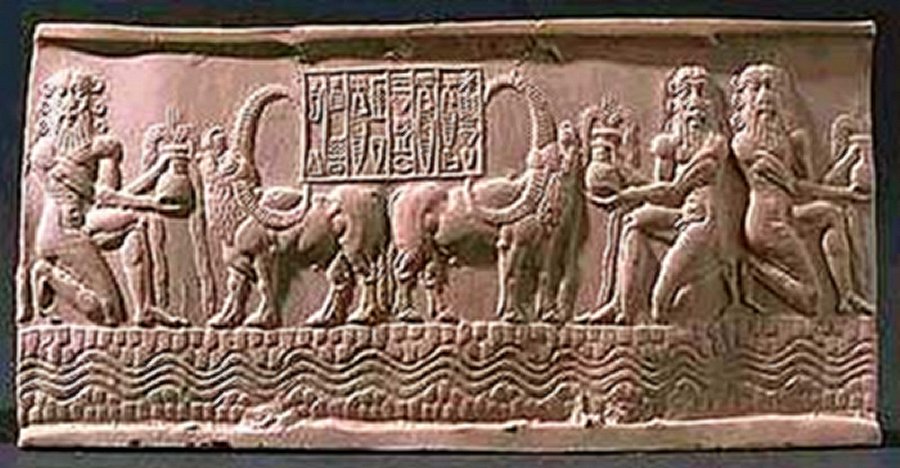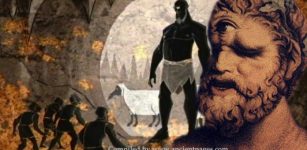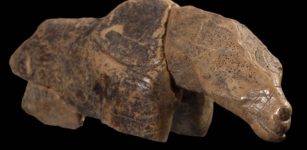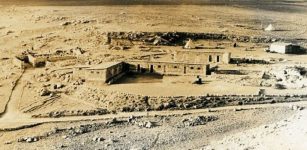How Did Sargon Become The Most Powerful Ruler Of Mesopotamia?
A.Sutherland - AncientPages.com - In 2334 BC, Sargon became the first emperor in the history of the world. Most probably, his great Akkadian kingdom was not a new creation and Sargon was only the successor to the long-established dominance of the city-state of Kish.
He was, however, one of the strongest known leaders in the first empire in the world.
He came from a humble background but eventually rose to the prestigious position of cup-bearer to Ur-Zababa, the king of Mesopotamia, who ruled the city of Kish, because of this position, Sargon was given leadership over an army.
Kish City (dated back 5,000 years), survived the Great Flood that happened some 7,600 years ago and was mentioned in Jewish, Christian, and Muslim scriptures. Kish is also well-known because this is the site strongly related to the famous King Sargon of Akkad.
Sargon - A Powerful Politician
He united the independent regions of Sumer into one state organism. But before Sargon’s fame could spread he had to get rid of Lugalzagesi ensi (“sacred king”) of the southern Mesopotamian city of Umma. Lugalzagesi reigned ca. 2375–50 BC, and it was before Sargon’s time.
This ruler was also a conquerer, who seized most of the territory of Lagash under king Urukagina (ca. 2375 BC), Kish, and the Sumerian cities of Ur and Uruk. He also had certain achievements that included uniting all of Sumer and extending his power to the Mediterranean coast but without annexation of the remote territories to his kingdom.
After the 25 year-long rule, King Lugalzagesi was eventually defeated by Sargon of Akkad, who became the ruler over large territories.
Sargon annexed the neighboring cities to his kingdom, invaded and conquered neighboring Sumer, Elam (western Iran), and Syria. He further reached Asia Minor, the Mediterranean Sea, and the Arab Gulf region. He founded or restored the already existing city of Akkad and made it the capital of the Akkadian Empire.
 Left: Prisoners escorted by a soldier, on a victory stele of Sargon of Akkad, circa 2300 BC.
Left: Prisoners escorted by a soldier, on a victory stele of Sargon of Akkad, circa 2300 BC.
The hairstyle of the prisoners (curly hair on top and short hair on the sides) is characteristic of Sumerians, as also seen on the Standard of Ur. Image credit: Louvre Museum. Right: A cuneiform tablet in the Sumerian language, telling about the birth of Sargon and his quarrel with King Ur-Zababa of Kish. The plate of the old Babylonian period. Source: Louvre Museum
No doubt, Sargon whose name means “the rightful king”, contributed to the greatness of Akkad that became the dominant political force in Mesopotamia, and raised the Akkadian state to the level of a well-administered empire.
During his reign from 2334-2279 BC, the country flourished. He regulated the irrigation canal network throughout the empire, organized a permanent army; reformed the system of measures and weights, roads were constructed and a postal system was created by using royal seals.
During his reign, attempts were also made to survey the population, and trade flourished between the Kingdom of Akkad the Indus Valley (in today's Pakistan), Oman, and islands in the Persian Gulf. Many highly prized products like lapis lazuli from today's Afghanistan, cedarwood from Lebanon, and silver from the Taurus Mountains were imported to the kingdom of Sargon.
Sargon’s rule lasted fifty-six years, and during this time, Akkadian language became the official language of Mesopotamia. No doubt, these were Sargon’s accomplishments that considerably helped to strengthen of Akkad’s dominant role.
 Impression of the Sharkalisharri cylinder seal, ca. 2183- 2159 BC during Akkadian, reign of Shar-kali-sharri. Mesopotamia. Cuneiform inscription in Old Akkadian. Credits: Louvre Musée
Impression of the Sharkalisharri cylinder seal, ca. 2183- 2159 BC during Akkadian, reign of Shar-kali-sharri. Mesopotamia. Cuneiform inscription in Old Akkadian. Credits: Louvre Musée
Several successful military campaigns helped him maintain order in the empire, however, not for long.
The ruler began to experience uneasiness and turbulence in the empire and faced repeated revolts. Some say, the ruler was punished by gods for some reason; however, if we rely more on historical sources that make attempts to separate fiction from the truth, Sargon’s ruling abilities were not satisfactory enough to keep the kingdom intact.
Toward the end of his reign, Sargon’s powerful and flourishing capital was besieged, but just before his death in 2279 BC, he managed to pass his empire to his sons for a period of 150 years.
At first, his successor was his son Rimush; after Rimush's death another son, Manishtushu, became king of Akkad, and finally, Manishtushu would be succeeded by his own son, Naram-Sin, who ruled 2261-2224 B.C and was the last great king of the Akkadian Empire.
Under Sharkalisharri c. 2217-2193 BC, the son of Naram-Sin, the Akkadian Empire collapsed.
Interestingly, his capital at Akkad is a legendary place because it has never been discovered, on the bank of the Euphrates River.
The city is mentioned in ancient texts but has not yet been identified by archaeologists. Several places have been proposed as the city of Akkad; Babylon, Sippar or possibly Kish, where Sargon first seized power.
Written by – A. Sutherland - AncientPages.com Senior Staff Writer
Copyright © AncientPages.com All rights reserved. This material may not be published, broadcast, rewritten or redistributed in whole or part without the express written permission of AncientPages.com
Expand for referencesReferences:
Malliaras T. Sargon the Great of Akkad 2340-2284 BC
Charles N. Pope, Living in Truth: Archaeology and the Patriarchs
More From Ancient Pages
-
 Ancient Mystery Of The Menorah – Enigmatic Sacred Object With Complex History
Featured Stories | Nov 5, 2018
Ancient Mystery Of The Menorah – Enigmatic Sacred Object With Complex History
Featured Stories | Nov 5, 2018 -
 Viking King – How Was He Elected And What Was Expected From Him?
Ancient History Facts | Apr 12, 2023
Viking King – How Was He Elected And What Was Expected From Him?
Ancient History Facts | Apr 12, 2023 -
 Amazing ‘Sigiriya’- ‘Lion Rock’ Fortress In Sri Lanka With Frescoes, Mirror Wall And Miniature Gardens
Civilizations | Jan 4, 2019
Amazing ‘Sigiriya’- ‘Lion Rock’ Fortress In Sri Lanka With Frescoes, Mirror Wall And Miniature Gardens
Civilizations | Jan 4, 2019 -
 Who Were Or Are The Ninja – Those Ancient Spies And Mercenaries?
Featured Stories | Jul 3, 2018
Who Were Or Are The Ninja – Those Ancient Spies And Mercenaries?
Featured Stories | Jul 3, 2018 -
 Shattering The Myth Of Men As Hunters And Women As Gatherers
Archaeology | Jun 29, 2023
Shattering The Myth Of Men As Hunters And Women As Gatherers
Archaeology | Jun 29, 2023 -
 35 Secret Underground Passageways Discovered Beneath Chavín De Huántar Temple Complex In Peru
Archaeology | Jun 1, 2022
35 Secret Underground Passageways Discovered Beneath Chavín De Huántar Temple Complex In Peru
Archaeology | Jun 1, 2022 -
 TB Was Transmitted in South America – DNA Study Shows How It Happened
Archaeology | Mar 17, 2022
TB Was Transmitted in South America – DNA Study Shows How It Happened
Archaeology | Mar 17, 2022 -
 Sha-Amun-en-su – Tragic Fate Of Ancient Egyptian Priestly Singer’s Unopened Sarcophagus
Featured Stories | Jun 25, 2021
Sha-Amun-en-su – Tragic Fate Of Ancient Egyptian Priestly Singer’s Unopened Sarcophagus
Featured Stories | Jun 25, 2021 -
 On This Day In History: Howard Carter Discovered King Tut’s Tomb In The Valley Of The Kings – On Nov 4, 1922
News | Nov 4, 2016
On This Day In History: Howard Carter Discovered King Tut’s Tomb In The Valley Of The Kings – On Nov 4, 1922
News | Nov 4, 2016 -
 On This Day In History: Heidelberg University Established – On Oct 19, 1386
News | Oct 19, 2016
On This Day In History: Heidelberg University Established – On Oct 19, 1386
News | Oct 19, 2016 -
 One-Eyed Giant Polyphemus – Most Famous Of The Cyclops In Greek Mythology
Featured Stories | Jan 25, 2018
One-Eyed Giant Polyphemus – Most Famous Of The Cyclops In Greek Mythology
Featured Stories | Jan 25, 2018 -
 12,000-Year-Old Crater Dipsiz (‘Bottomless’) Lake, Searched For Gold, And Destroyed In Legal But Controversial Excavation
Archaeology | Nov 17, 2019
12,000-Year-Old Crater Dipsiz (‘Bottomless’) Lake, Searched For Gold, And Destroyed In Legal But Controversial Excavation
Archaeology | Nov 17, 2019 -
 Stone Homes Of Europe’s First Megalithic Builders Discovered
Archaeology | Feb 22, 2023
Stone Homes Of Europe’s First Megalithic Builders Discovered
Archaeology | Feb 22, 2023 -
 Curious Ice Age Figurine Of Unidentified Animal Species Puzzles Scientists
Archaeology | Jul 31, 2023
Curious Ice Age Figurine Of Unidentified Animal Species Puzzles Scientists
Archaeology | Jul 31, 2023 -
 The Assyrian Siege Ramp And Breached Walls At Canaanite City Of Lachish – Studied
Archaeology | Nov 10, 2021
The Assyrian Siege Ramp And Breached Walls At Canaanite City Of Lachish – Studied
Archaeology | Nov 10, 2021 -
 Mysterious Balochistan Sphinx Has An Ancient Story To Tell – But Is An Advanced Ancient Civilization Or Mother Nature Hiding Behind The Story?
Featured Stories | Feb 3, 2018
Mysterious Balochistan Sphinx Has An Ancient Story To Tell – But Is An Advanced Ancient Civilization Or Mother Nature Hiding Behind The Story?
Featured Stories | Feb 3, 2018 -
 Huge 2,000-Year-Old Roman Basilica Discovered In Israel May Have Been Built By Herod The Great
Archaeology | Jul 29, 2021
Huge 2,000-Year-Old Roman Basilica Discovered In Israel May Have Been Built By Herod The Great
Archaeology | Jul 29, 2021 -
 Patara Lighthouse Built By Emperor Nero In 64 AD Will Shine Again
Archaeology | Mar 5, 2020
Patara Lighthouse Built By Emperor Nero In 64 AD Will Shine Again
Archaeology | Mar 5, 2020 -
 Unique Well-Preserved 16th-17th Century Fabrics And Shoes Found In Toruń, Poland
Archaeology | May 13, 2024
Unique Well-Preserved 16th-17th Century Fabrics And Shoes Found In Toruń, Poland
Archaeology | May 13, 2024 -
 Rare Eleventh-Century Astrolabe Unearthed Recently Sheds Light On Islamic-Jewish Scientific Exchange
Scripts, Paintings & Inscriptions | Mar 4, 2024
Rare Eleventh-Century Astrolabe Unearthed Recently Sheds Light On Islamic-Jewish Scientific Exchange
Scripts, Paintings & Inscriptions | Mar 4, 2024

